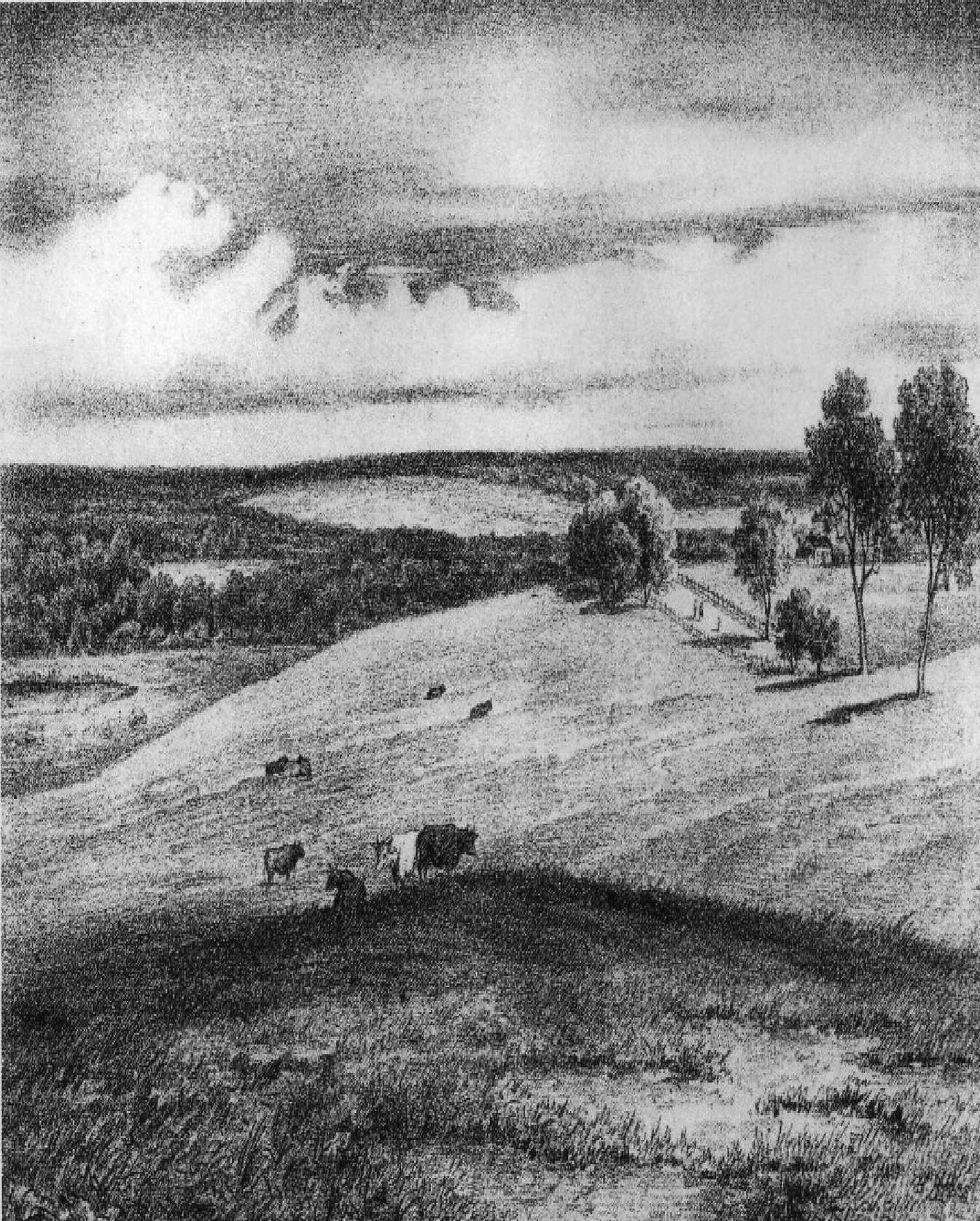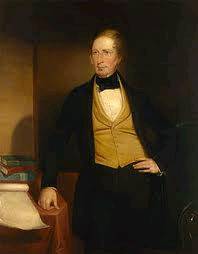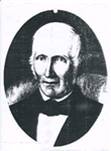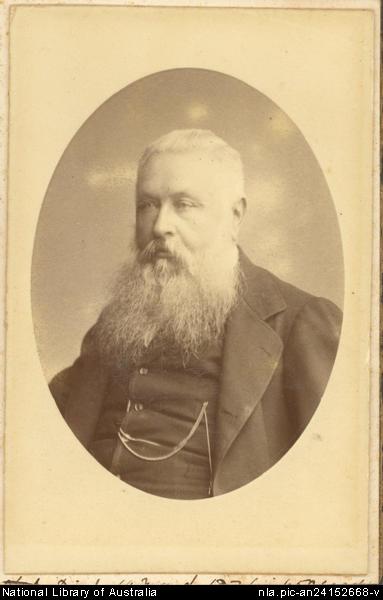 |
 |  |  |  |  |  |  | | |
THE SCENIC HILLS FROM DENHAM COURT 1884

Pencil sketch by Harold Brees (Source: Mills & Pile, Terms and Conditions of Sale of the Estate, 1884). The views from Denham Court along Campbelltown Road remain much the same today but are at risk from rampant development.
____________________________
FAMOUS PEOPLE IN THE SCENIC HILLS
Dr. Robert Townson (painting in the Mitchell Library, Sydney), original owner of Varro Ville from 1809 to 1827. Townson, Doctor of Civil Laws and gentleman scientist, was the most educated man in the NSW colony when he arrived in 1807, speaking five languages and author of a number of books (depicted on the table in the painting above).

Austrialian Explorer, Captain Charles Sturt (painting in the National Gallery, Adelaide), owner of Varro Ville from 1837 - 1839.

James Raymond, NSW's first Postmaster General, owner of Varro Ville 1839 - 1851, sold after his death by his sons in 1857. James Raymond created a world first when he introduced prepaid postage to the colony.

Judge Alfred Cheeke (picture from the National Library of Australia), appointed to the Supreme Court of NSW, owner of Varro Ville 1859 - 1876, built the current (third) house on the property. Cheeke presided at the trial of Fenian H. J. O' Farrell who had attempted to assassinate the visiting Duke of Edinburgh in 1868. Cheeke used Varro Ville to breed and train horses. There he bread and trained 'Clove' who won the first AJC Derby recorded in the Turf Register in 1865.
| |
|
|
 |
|
 | | 
 |
|
______________________________________________________________________
THIS PAGE IS STILL UNDER CONSTRUCTION - PLEASE RETURN AGAIN SOON
______________________________________________________________________
Before European settlement - the Yandel'ora
The Scenic Hills are
central to a geographical area known as the Yandel’ora “land of peace between
peoples”. This was a vast meeting area centred on Mount Annan but including the
upper reaches of Bunbury Curran Creek, and the land to the west of Appin Road
down to the banks of the Nepean River. At least once in a generation hundreds
of thousands of aboriginal people from south eastern Australia gathered,
leaving their weapons outside the area, to settle disputes in a peaceable
manner, to clarify law and arrange marriages here. Tribes came from as far
north as Maroochydore and as far south as Melbourne, but may also have included
some from Central Australia and Tasmania. Its significance extends beyond the
artefacts and landmarks found here, applying instead to the whole land area and
its sense of place. The Yandel’ora has been encroached on by Camden, Narellan, Campbelltown and its
suburbs, with the South West Growth Centre encroaching further from the Camden
and Liverpool sides. The national importance and symbolism of the Yandel’ora as
a place of peace and meeting between people needs to be nationally recognised
and preserved before it is too late. The Scenic Hills are an important remnant.
Source: Royal Botanic Gardens website & Father Greg Burke of the Carmelite Retreat Centre at Varroville (near Campbelltown).
______________________________________________________________________
European Settlement - the Birthplace of the NSW Pastoral Industry
The South West of
Sydney is the birthplace of the Pastoral Industry in NSW. It is historically
famous as the Cow Pastures area [1] and the properties located here were romanticised by early 20th
century architect Hardy Wilson in his now rare book “The Cow Pasture Road”,
1920 [2].
This book became the inspiration for a series of tours of the same properties
by NSW Historic Houses Trust (HHT) over the last four years.
In 2000, foreseeing
the adverse impact that urbanisation (in particular the South West Growth
Centre) could have on this historic area, the NSW Heritage Council commissioned
the National Trust to conduct a study. In the ground-breaking report that
emerged from this, Colonial Landscapes of
the Cumberland Plain and Camden, NSW, authors Colleen Morris and Geoffrey
Britton [3] wrote:
“An overriding consideration for
this entire study is that there remain within the Cumberland Plain and nearby
areas, rural landscapes and landscape features of cultural value on account of
their ability to demonstrate important aspects of early European occupation –
gardens, vineyards, orchards, paddocks, fences, cemeteries, grant areas,
windbreaks and accessways…These early colonial landscapes are, collectively of exceptional significance [our
emphasis] for their ability to demonstrate the interaction of the early
European settlers with the Australian landscape…One of the key
recommendations of the report was to adopt “a
special category of zoning within the environmental planning framework – such
as Environmental Protection Zone 7 – especially for the conservation of
important cultural landscapes as a whole and large landscape curtilages...”
The
implementation of this report has been less than satisfactory with many of the
heritage landscapes lost to inappropriate development under the previous NSW
government. What remains is a precious and increasingly rare reminder of our
past. The Scenic Hills (Central Hills Lands) are one of the few remaining
landscapes where the context of
these properties remains relatively intact and where colonial views are
retained from the important Cowpastures Road (now Camden Valley Way) and
Campbelltown Road. Update: Since writing this last sentence, Camden Council has rezoned all the land along the former Cowpastures Road that was part of the Scenic Hills, and the Roads and Maritime Services has upgraded and widened Camden Valley Way destroying its history and heritage. Nothing has changed with the change of government except the pace with which the O'Farrell Government is destroying our heritage and environment. This makes the retention of Campbelltown's Scenic Hills even more essential.
[1] The Cow
Pastures takes its name from an incident occurring within the first years of
the colony. In 1788, Captain Arthur Phillip had brought with him on the HMS
Sirius, a herd of cattle (two bulls and seven cows). Disastrously, these cattle strayed within
five months and despite an extensive search were not found until seven years
later, grazing contentedly on open pasture near the Nepean River and now
numbering sixty one. As it was presumed
that the cattle had understood how to choose the best pasture for themselves,
they were left to graze there and were protected by future governors. Not
surprisingly, early colonists followed their example and set up their early
pastoral holdings in the area. (Note: The specific detail of the above incident
varies according to the source.)
[2] Hardy Wilson, The
Cow Pasture Road, Art in Australia, Sydney, 1920.
[3] Colleen Morris
and Geoffrey Britton, Colonial Landscapes
of the Cumberland Plain and Camden, NSW: A Survey of selected pre-1860 Cultural
Landscapes from Wollondilly to Hawkesbury LGA, National Trust, 2000, p. 4.
________________________________________________________________________________
Leppington at the Northern End of the Scenic Hills
[under construction] ______________________________________________________________
Denham Court at the North Eastern End of the Scenic Hills
[under construction]
______________________________________________________________
Varro Ville in the heart of the Scenic Hills
The old Varro
Ville estate is
located in picturesque rolling country known locally as ‘the Scenic Hills’ near
Minto between the old Cowpasture Road (Camden Valley Way) and Campbelltown Road
in the County of Cumberland. It was originally a grant of 1000 acres made by Governor
Lachlan Macquarie to Dr Robert Townson in 1810. When Townson arrived in Sydney in 1807
he was the most educated man in the colony: a Doctor of Civil Laws, a natural
scientist and Fellow of the Royal Society of Edinburgh, he spoke five languages
and was much published.
Townson
named his property ‘Varro Ville’ after another man of letters, Marcus
Terentius Varro (116-37 BC), who wrote extensively on Roman agriculture. In
1810 Governor Lachlan Macquarie visited the estate, noting in his diaries that
the farms of Townson (Varro Ville) and
Thomson (St. Andrews, opposite) were “by far the best pasturage
I have yet seen in the colony”. He also remarked on the “noble
extensive view…of the surrounding countryside…[1] which he obtained from the top of Bunbury Curran Hill, the highest point on
the range cutting through the estate.
By
the time of his death in 1827 Townson had made the estate an exemplar of 19th century
agriculture worthy of its name [2]. The estate was subsequently
owned by a number of other important colonial figures: most notably the explorer
Captain Charles Sturt who, in the 1830s altered watercourses and put ‘water
holes’ (dams) in every paddock, thereafter citing it as a ‘model of water
conservation’ in his public speeches [3], and Justice Alfred Cheeke
of the Supreme Court of NSW who established a horse stud at Varroville in
1859, and a private racecourse on the flats below the house (now adjacent to
the M5). There he bred and trained the horse 'Clove' which won the first
recorded AJC Derby in 1865. James
Raymond also used Varroville as his country retreat between 1839 and1851.
Raymond was the first Postmaster General in the Colony and introduced the
world’s first system of pre-paid postage.
Varro
Ville House c.1858-59
is the third house built on the estate and is attributed to the former Colonial
Architect (1854-56) William Weaver in partnership with William Kemp. Both
Weaver and Kemp had worked under Edmund Blacket when he was the Colonial
Architect between1849 to 1854. Weaver took over as Colonial Architect when
Blacket left to work on Sydney University.
Varro
Ville House is a substantial single storey, rendered brick house on a stone foundation,
with service wings enclosing a courtyard at the rear. A large underground water
tank extends westwards from the ends of the wings of the house. While similar
in style to other Italianate villas of the mid-19th century (such as Yasmar at
Haberfield, designed by John Bibb c1852), Varro Ville House, however, is rare in NSW for its synthesis of house and landscape. The house
occupies a narrow ridge on the south side of Bunbury Curran Hill and is
oriented east-west, taking advantage of vistas to other Cumberland Plain
homesteads Denham Court and Macquarie Field House [4], but is remarkable for the superior view through the back door across the courtyard to the range beyond, which may have aboriginal connections to the site.
The siting of Varroville house, which avoided the house being
silhouetted against the sky, was endorsed by the horticulturalist and landscape
designer, Thomas Shepherd (1776-1836), probably citing the British landscape
architect Humphry Repton, when describing the siting of Elizabeth Bay House in
Sydney and later discussed by British writer on estate planning, John Claudius
Loudon (1773-1843) whose writings were influential in colonial New South Wales.
Confirming its integration with the landscape, a recent study [5] discovered the existence
of a deliberate ‘landscape park’ intention in the land surrounding Varro Ville
house. The remnants of a graveled driveway (since intersected at
Cambelltown Road by the M5) meanders through clumps of 19th century
Cumberland Plain woodland, early vineyard terracing and dams, ending in a southerly
approach to the front of the house with Bunbury Curran Hill looming in the distance.
On the northern side, cascading dams, each with their own catchment area
emulate the made-made water features at the core of 18th century landscape gardens.
The park possibly dates from Townson’s or Sturt’s time, both men being enthusiastic
horticulturalists educated in the landscape trends of the time, but could also
be the work of Weaver who appears to have given the property a major make-over
when the current house was built - including the adjoining cottage (c.1810
–1815 probably the first house on the estate but later used as a gardener's cottage) and the pre-1830 coach house.
In
the immediate surrounds the gravelled carriage drive, lawn tennis court site
and plantings are elements of a substantiall intact mid-19th century
garden plan. The garden contains Moreton Bay figs, hoop pines, funeral
cypresses, white cedars, pepper and coral trees, a Norfolk Island hibiscus, Bauhinia,
agaves, oleanders [6],
Mauritius hemp (the stretch of original drive in front of the house is a forest
of these), yuccas, aloes and hedges of Tecomaria capensis, common olive
and African boxthorn [7]. The kitchen garden, laid
out in 1809 and described in Sturt’s 1839 sale advertisement may have occupied
sloping ground to the north- west of the house [8].
In
1974 Campbelltown City Council re-zoned the Scenic Hills from Denham Court Road to Menangle creating an Environmental
Protection area that has ensured the intact survival of 800 acres of the original Varro
Ville estate and its remaining colonial rural heritage. In a report commissioned in 2000 by the NSW Heritage Council, the authors noted about Varro Ville: "[it] is one of the few estates remaining in the Campbelltown area where the form of the original grant and the former agricultural use of the estate is still appreciable to any great extent." [9]
Unfortunately, in the 1970s Campbelltown City Council allowed the then owners (Morris and Cherry Jackaman) to subdivide the house onto eight acres separating it from its earlier outbuildings and other agricultural and estate features. In 2007 land
developers bought the surrounding land, including the outbuildings which are
now falling into disrepair.
Postscript: In 2011 the Sydney Morning Herald found that the suburb of Varroville near Campbelltown, with a population of only 149 people, had the highest concentration of people with post-doctoral degrees...thus continuing a tradition of high scholarship begun by Dr Townson in 1809 when he first acquired the estate that gave the suburb its name.
Source: Jacqui Kirkby, expanded text originally prepared in 2009 for Branch Cuttings, the newsletter of the Sydney and Northern NSW Branch of the Australian Garden History Society, updated in 2012.
[1] Lachlan Macquarie: Journals
of his Tours in New South Wales and Van Dieman’s Land 1810-1822, Sydney
1979.
[2] Obituaries in Sydney
Gazette, June 291827 and July 13, 1827.
[3] Mrs Napier Sturt, Life
of Charles Sturt, Elder & Co., London, 1899, & sale notice in the
Australian, 31st January 1839.
[4] Colleen Morris and
Geoffrey Britton considered this to be a deliberate siting intention in their Colonial
Landscapes of the Cumberland Plain and Camden, NSW: A Survey of selected
pre-1860 Cultural Landscapes from Wollondilly to Hawkesbury LGA, National
Trust, 2000 for Heritage Council of NSW.
[5] Geoffrey Britton, Varroville:
Landscape Analysis, November, 2007.
[6] Hardy Wilson described
many oleanders at Varroville in, The Cow Pasture Road, Art in
Australia, Sydney, 1920.
[7] Adapted from Scott
Carlin’s Historic House Trust notes for their Cowpasture Road tours in 2007.
[8] The Australian 31st
January 1839.
[9] Colleen Morris and Geoffrey Britton, ibid. p.97
_________________________________________________________________
Mount Annan at the Southern End of the Scenic Hills
[under construction]
 |
|











